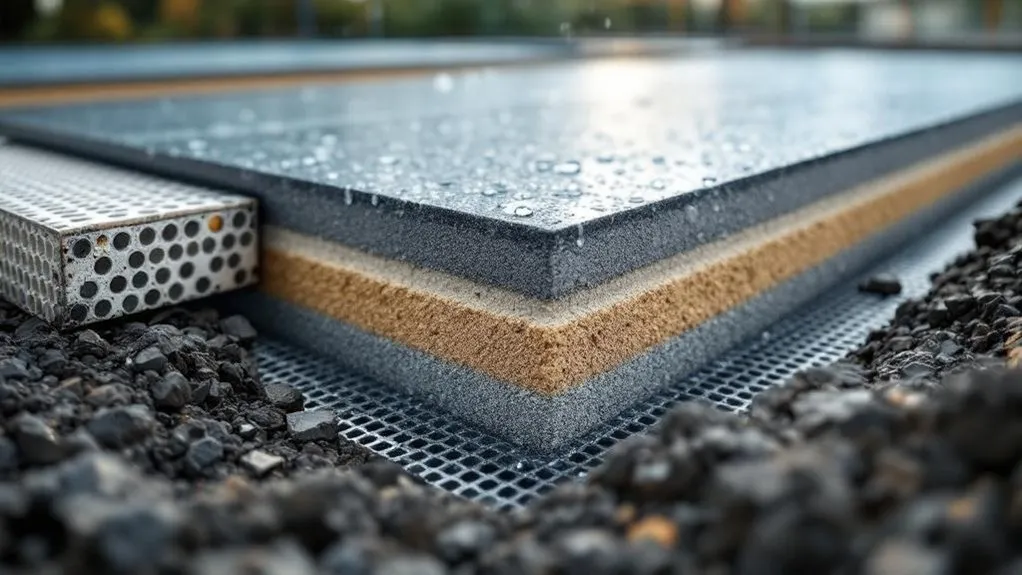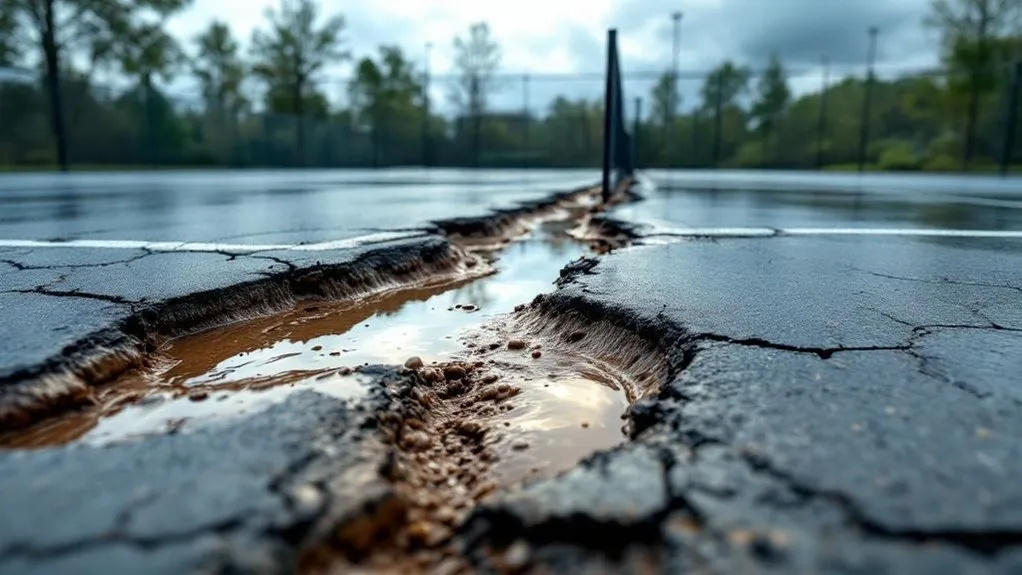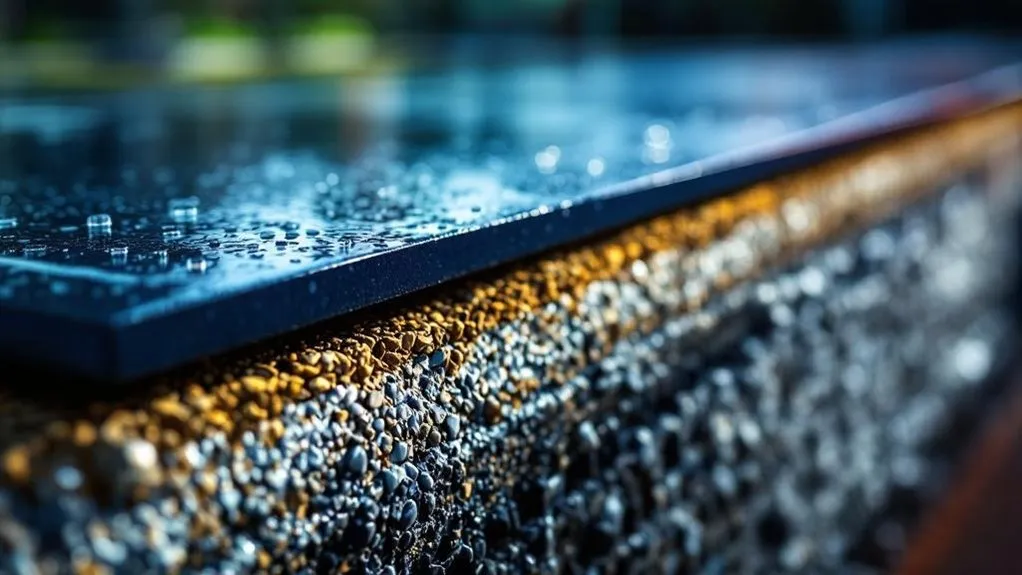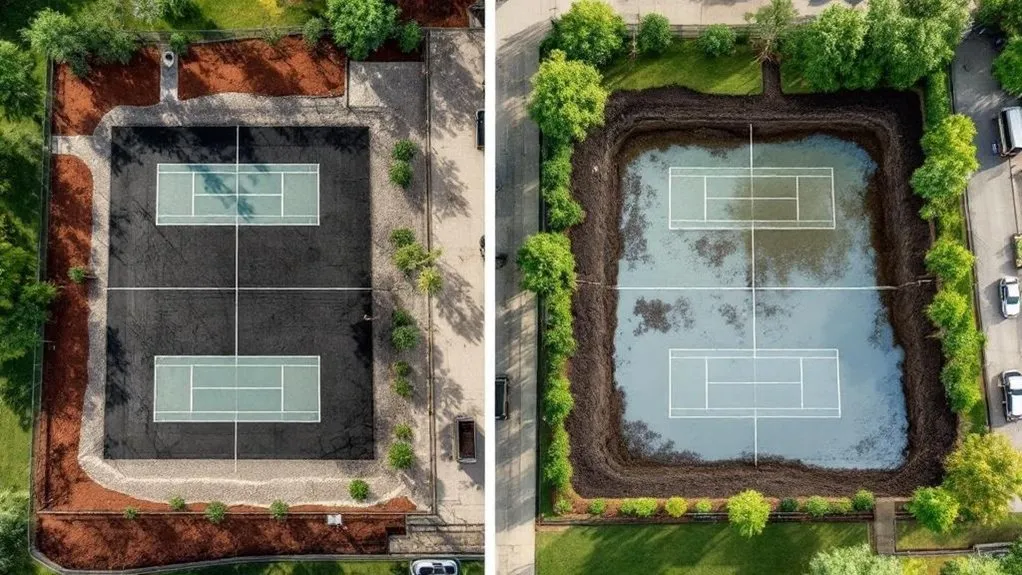You’ve invested thousands in your pickleball court, but without proper drainage and grading, you’re watching your investment slowly deteriorate with every rainfall. Water pooling on your court surface isn’t just an inconvenience—it’s actively destroying the foundation, creating safety hazards, and potentially exposing you to costly liability issues. Most court owners are unaware that 80% of premature surface failures originate from a single critical oversight during the initial design phase.
Key Takeaways
- Proper drainage prevents water accumulation, surface damage, and structural issues while maintaining optimal playing conditions year-round.
- Ideal court slope ranges from 1% to 2% across the width with minimal grade variation along the length.
- Crown grading at center slopes toward the sidelines to effectively direct water away and prevent pooling.
- Different court materials require specific drainage solutions: asphalt needs subsurface drains, and concrete requires perimeter drainage systems.
- Regular maintenance, including debris clearing and grade inspection, prevents costly repairs and ensures safe playing surfaces.
Understanding the Science Behind Proper Court Drainage

Anyone who’s stepped onto a waterlogged pickleball court knows that poor drainage doesn’t just interrupt play—it can destroy the entire playing surface.
Water that can’t escape creates hydrostatic pressure beneath your court, causing cracks, shifting, and surface deterioration. You’re dealing with the physics of gravity, soil permeability, and water flow.
When water accumulates, it weakens the foundation and creates freeze-thaw cycles that’ll fracture your investment.
Proper drainage systems work by directing water away through subsurface drains, permeable materials, and strategic grading.
You’ll need to understand how water moves through different soil types to design an effective drainage solution that protects your court long-term.
Optimal Grading Specifications for Pickleball Courts
A mere quarter-inch difference in court slope can mean the difference between perfect drainage and standing water that’ll ruin your playing surface.
You’ll want to establish a 1% to 2% grade across your court’s width, ensuring water flows toward designated drainage areas. Avoid slopes exceeding 2%, as this creates uneven play conditions and affects ball bounce consistency.
Your court’s length should maintain minimal grade variation—less than 0.5% is ideal. Install crown grading at the center of the court, sloping gently toward both sidelines.
This dual-directional drainage prevents water accumulation while maintaining the level playing field essential for competitive pickleball.
Common Drainage Problems That Destroy Playing Surfaces

Poor drainage doesn’t just create puddles—it systematically destroys your court’s foundation, surface integrity, and playability.
Standing water penetrates surface cracks, causing freeze-thaw damage that creates larger fissures and uneven playing areas. You’ll notice surface deterioration accelerates when water pools consistently in the same spots, leading to soft spots and eventual structural failure.
Inadequate slope creates persistent wet areas where algae and moss thrive, making courts dangerously slippery.
Poor subsurface drainage causes the base material to shift and settle unevenly, creating dips and high spots that affect ball bounce and increase the risk of injury, while requiring expensive repairs.
Essential Drainage Systems for Different Court Types
Now that you understand how drainage failures wreak havoc on court surfaces, let’s examine the specific systems that prevent these costly problems. Your drainage choice depends on the type of court construction and local conditions.
For asphalt courts, you’ll need subsurface drains with gravel beds beneath the base layer. These channels allow water to flow away before it penetrates the surface.
Concrete courts require perimeter drains and proper slope gradients toward collection points.
Post-tensioned concrete systems benefit from French drains along edges.
Meanwhile, modular tile surfaces need adequate subgrade preparation with permeable base materials. Each system requires a tailored approach to ensure optimal water management and surface longevity.
Surface Materials and Their Impact on Water Management

When choosing your pickleball court surface, you’re fundamentally selecting how your court will handle water for decades to come.
Asphalt surfaces require proper sealing and regular maintenance to prevent water infiltration, which can lead to cracking and heaving.
Concrete offers superior durability, but it requires adequate drainage underneath to prevent hydrostatic pressure buildup.
Post-tensioned concrete systems offer excellent water resistance, but require precise installation.
Cushioned acrylic surfaces shed water quickly when correctly applied over sound substrates.
Modular tiles offer built-in drainage channels between panels, making them ideal for areas with heavy rainfall.
Your surface choice directly impacts long-term maintenance costs and court performance.
Climate Considerations in Drainage Design
Your local climate patterns determine every aspect of your drainage system design, from pipe sizing to slope calculations.
To create an effective water management system, you’ll need to analyze rainfall intensity, frequency, and seasonal variations.
Consider these critical climate factors:
- Rainfall intensity – Design for your area’s heaviest expected downpours, not average precipitation
- Freeze-thaw cycles – Install deeper drainage lines below the frost line in cold climates
- Humidity levels – Account for condensation and moisture retention in humid environments
- Seasonal drainage – Plan for spring snowmelt and seasonal water table fluctuations
Your drainage capacity should be sufficient to handle the worst-case weather scenarios in your region.
Professional Installation vs. DIY Drainage Solutions

While proper drainage design requires technical expertise, deciding between professional installation and DIY implementation depends on the complexity of your project, local regulations, and your skill level.
Simple surface drainage and basic grading might suit experienced DIYers with proper tools. However, subsurface drainage systems, French drains, and complex grading require professional expertise.
You’ll need permits for major drainage modifications in most areas. Consider soil conditions, water table depth, and the impact on neighboring properties.
Professional installation ensures code compliance, utilizes proper materials, and provides warranties. DIY mistakes can lead to costly water damage, court failures, and legal issues.
Evaluate your capabilities honestly before proceeding.
Maintenance Requirements for Long-Term Performance
Even after installing the most sophisticated drainage system, you’ll need consistent maintenance to preserve your pickleball court’s performance and longevity.
Regular upkeep prevents costly repairs and guarantees ideal playing conditions year-round.
Essential maintenance tasks include:
- Clearing debris from drains, gutters, and surface areas monthly
- Inspecting grade integrity after heavy rainfall or seasonal changes
- Cleaning drainage channels to prevent clogs and water backup
- Sealing surface cracks immediately to prevent water infiltration
Establish a seasonal inspection schedule to address minor issues before they escalate into significant problems.
Proper maintenance significantly extends your court’s lifespan while maintaining consistent ball bounce and ensuring player safety standards.
Cost Analysis of Proper Drainage Investment

| Cost Category | Poor Drainage | Proper Drainage |
|---|---|---|
| Initial Installation | $15,000 | $22,000 |
| 5-Year Repairs | $8,000 | $1,500 |
| 10-Year Resurfacing | $12,000 | $6,000 |
| Total 10-Year Cost | $35,000 | $29,500 |
| Annual Maintenance | $800 | $300 |
You’ll save $5,500 over ten years, plus reduce ongoing maintenance costs by investing in quality drainage infrastructure upfront.
Legal and Safety Implications of Poor Water Management
Beyond the financial considerations, inadequate drainage creates serious liability risks that can expose court owners to costly lawsuits and regulatory violations.
You’re legally responsible for maintaining safe playing conditions. Poor water management transforms your court into a hazardous environment where players can suffer serious injuries from slips, falls, and collisions on wet surfaces.
Key legal and safety risks include:
- Slip and fall lawsuits from players injured on standing water or wet surfaces
- Insurance claim denials due to negligent maintenance of drainage systems
- ADA compliance violations occur when water accumulation blocks accessible pathways
- Municipal code violations for improper stormwater management affecting neighboring properties
Proper drainage isn’t optional—it’s essential liability protection.
Frequently Asked Questions
Can Existing Tennis Courts Be Converted to Pickleball With Proper Drainage Modifications?
You can convert existing tennis courts to pickleball with the proper drainage modifications.
You’ll need to assess the current drainage system and potentially install additional drains or improve grading to handle water runoff effectively.
Since pickleball courts are smaller, you can fit multiple courts on one tennis court. Still, you’ll want to guarantee proper water management across the entire surface for ideal playing conditions and court longevity.
How Long Does Pickleball Court Drainage Installation Typically Take to Complete?
You’ll typically need 3-7 days for pickleball court drainage installation, depending on the size and complexity of your court.
If you’re starting from scratch, expect longer timelines due to excavation and base preparation.
Weather conditions can significantly extend your project timeline.
You’ll find that simple surface drainage systems install faster than thorough subsurface solutions.
Most contractors complete basic drainage work within a week, but you should plan for potential delays during wet seasons.
What Permits Are Required for Installing Drainage Systems on Residential Pickleball Courts?
You typically need a building permit for the installation of a residential pickleball court drainage system.
Most municipalities require permits for excavation work, particularly when it involves changes to grading or connections to existing drainage systems.
You might also need separate permits for electrical work if you’re installing lighting.
Contact your local building department early in the planning process, as permit requirements vary considerably by location, and some areas have specific regulations for recreational court construction.
Do Indoor Pickleball Courts Need the Same Drainage Considerations as Outdoor Courts?
Indoor pickleball courts don’t require the same extensive drainage systems as outdoor courts, as they’re protected from rain and weather.
However, you’ll still want to consider moisture management for cleaning, humidity control, and potential spills.
Focus on proper ventilation, slight slopes toward floor drains for maintenance, and moisture barriers beneath the surface.
You won’t need the complex grading and drainage infrastructure required for outdoor courts that must handle heavy rainfall.
Can Smart Drainage Monitoring Systems Be Integrated Into Pickleball Court Designs?
You can integrate innovative drainage monitoring systems into your pickleball court design.
These systems use sensors to detect moisture levels, flow rates, and potential blockages in real-time. You’ll receive alerts on your smartphone when drainage issues arise, allowing you to address problems before they affect playability.
The technology continuously monitors subsurface drainage performance, helping you maintain ideal court conditions and extend the lifespan of your surface through proactive maintenance scheduling.
